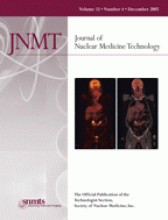We thank Currie and Wheat for their comments on our article (1). We are aware of the variations in acquisition protocols for gated myocardial perfusion SPECT among different centers. There is a recommendation, but no clear consensus, on this matter (2). In some instances, potentially better techniques and protocols have been described in the literature. These either are not routinely available in commercial systems or have yet to be adequately validated in clinical settings. For the sake of brevity, detailed discussion of all the techniques was beyond the scope of our article. We principally focused on the techniques that are widely accepted and routinely used in clinical practice. We appreciate Currie and Wheat’s comments and consider them a valuable adjunct to our article.
In our article, we did not recommend any particular protocol, technique, or processing program. Rather, we emphasized general principles. The protocols were cited strictly as examples. In our experience, the clinical consequence of a narrow window on perfusion data acquisition is not significant if the subject is on sinus rhythm or not severely arrhythmic. If all subjects are routinely gated, a wider window is certainly a better approach, because with a narrow window, a greater number of beats will be rejected in arrhythmic patients. However, even a 100% window does not include all the beats, because only beats within ±50% of the expected R-R interval will be accepted. The suggestion of an additional bin is an attractive alternative to maintain the integrity of the perfusion data (3).
Our comment that a narrow window will prolong the image acquisition was based on the count-based acquisition mode. Because the beat rejection rate is high in arrhythmic patients, acquisition has to be prolonged—too long, in some cases, to collect the desired counts. In fact, whatever the acquisition strategy is, the question as mentioned by Currie and Wheat still remains: Can we completely eliminate the interprojection nonuniformity of the counts, time, or number of beats? If one variable is kept fixed during the acquisition, the potential for variation in other variables persists. For practical purposes, we consider this variation acceptable except in patients with significant arrhythmia. However, to expand the application of gated myocardial perfusion SPECT in a wider spectrum of patients, a better strategy is clearly needed.







